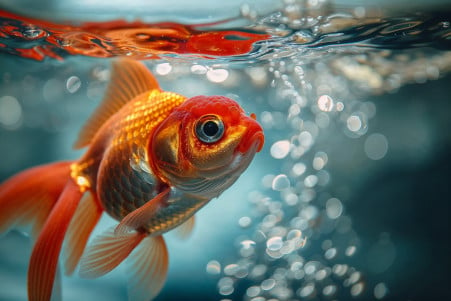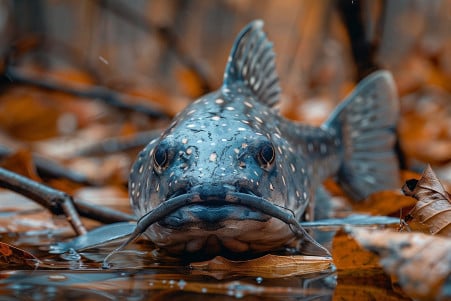How Long Can Fish Live Out of Water? Insights into Aquatic Survival
14 March 2024 • Updated 14 March 2024

Fish are obviously built to live in water, but their ability to survive out of water varies greatly between species. While some fish, like the lungfish, can survive for months by creating mucus cocoons and entering a state of estivation, most fish can only survive for a few minutes to a few hours before their gills collapse or they die of dehydration.
This article will delve into the physiological adaptations and survival strategies of different types of fish, and will reference studies in the fields of biology and environmental science. Through an examination of respiration and osmoregulation and an investigation into the ways different species have adapted to survive, this in-depth overview will give you a better understanding of the factors that limit and enable fish to survive outside of their natural environment.
How long can fish live out of water?
The Aquatic Breath Revealed: Gill Structure and Air-Breathing in Fish
Fish, often referred to as the gilled champions of aquatic respiration, are able to extract oxygen from water with impressive efficiency. This oxygen is vital to their existence, as it powers their metabolic functions, according to Live Science.
Gills, which are covered in thousands of tiny, finger-like projections and blood vessels, provide a large area for this essential gas exchange. In fact, fish are able to extract up to 75% of the oxygen that passes over their gills, Live Science reports.
However, the collapse of these fragile, water-adapted organs when fish are exposed to air means that the fish will die from suffocation.
For example, anabantoidei fish have adapted to this challenge by developing a secondary method of respiration, complete with an anabantoidei organ that allows them to take in air at the water’s surface, Encyclopaedia Britannica explains. This adaptation is so important that it allows them to survive in waters with low oxygen levels, even for hours on land.
A study by Dr. Kathleen M. Gilmour, published in PMC, explains that fish are able to modify their breathing patterns in response to changes in their environment. This ability is important to ensure that their oxygen intake matches their oxygen needs.
Yet, the question remains: how long can a fish live out of water? While the answer is variable, the rapid loss of gill function often means that fish have only minutes to hours before their ability to breathe becomes compromised, demonstrating the delicate balance that these aquatic breathers must maintain.
The Balancing Act: Osmoregulation in Fish
Osmoregulation is the physiological process that enables fish to maintain the proper balance of salts and water inside their bodies, a balance that is necessary for their survival. Osmoregulation is a highly complex process that involves the regulation of water and ion movement to maintain the proper solute concentrations and water levels, according to PetMD.
One of the most significant osmoregulatory challenges fish face is when they are taken out of water. When fish are out of water, their gills, which are essential for osmoregulation, are exposed to the air, which disrupts the balance of salt and water inside the fish.
Freshwater fish have to deal with the issue of water moving into their bodies and salt moving out, and they do so with the help of specialized cells and efficient kidneys.
In contrast, marine fish have to deal with the issue of too much salt moving into their bodies and water moving out, and they do so by drinking seawater and actively excreting salts through their gills, according to JoVE.
The energy demands of these processes are high. Marine fish have to expend a lot of energy to get rid of excess salt, which is an energy-demanding process, according to PetMD. When fish are taken out of water, their energy reserves can be depleted quickly, which would normally be used for osmoregulation, and this can lead to a dangerous imbalance of salts or dehydration.
For example, euryhaline species like salmon are able to demonstrate remarkable adaptability by altering their osmoregulatory processes as they move between environments with varying salinity levels, which is evidence of their capacity to evolve, according to research in JoVE.
This balance, which is essential for the health and survival of fish, is just an introduction to the amazing adaptations of air-breathing fish. These adaptations will be explored further in the next section, which will focus on the incredible ways they are able to survive out of water.
Evolutionary Marvels: The Air-Breathing Adaptations of Fish
Mudskippers and lungfish, as evolutionary marvels, have evolved specialized air-breathing adaptations that allow them to live on land for extended periods of time. These adaptations are more than just interesting biological oddities; they are essential for understanding the evolution of vertebrates from water to land.
For example, a study in PMC notes that mudskippers have modified fins that allow them to move on land and eyes that have adapted to vision in the air, which has allowed them to retain accurate vision in both air and water.
The evolutionary importance of these adaptations is that they are similar to the early adaptations of terrestrial vertebrates. As the Journal of Experimental Biology explains, the genetic and physiological changes in these amphibious animals, including increased ammonia tolerance and changes in immune function, are similar to the evolutionary changes that happened millions of years ago when vertebrates first moved from water to land.
As ScienceDirect explains, the ability to control respiration through specialized air-breathing organs is a critical adaptation. These organs, along with changes in the nervous system, allow for more efficient extraction of oxygen from the air.
Meanwhile, recent studies of the survival times of air-breathing fish have shown that these animals are incredibly resilient and have evolved complex adaptations, including the ability to switch to anaerobic ATP production when oxygen levels are low. These findings help scientists better understand the short-term survival mechanisms that fish have evolved in response to acute exposure to air.
Fish’s Acute Stress Responses
When fish are suddenly taken out of the water, they undergo an acute stress response that is similar to that of other vertebrates.
According to a study in PubMed, this response is mediated by the activation of neuroendocrine pathways that help to maintain essential processes like oxygen transport and energy release, while suppressing non-essential processes like growth and immunity.
A review in Integrative and Comparative Biology explains that the main stress hormone, cortisol, is released into the bloodstream within minutes of a fish being exposed to a stressor. This cortisol release is important because it helps the fish’s body shift its resources to deal with the sudden change in its environment.
The release of cortisol can vary widely between different fish species due to differences in their evolutionary history and the many different environments they live in. In fact, a study by Barton, as cited in the review, found that the magnitude of the response is determined by genetic and environmental factors, and some species have a much stronger and longer-lasting cortisol response than others.
A study in PMC even suggests that the flexibility of the stress response is important for survival in the short term and shows how well fish have adapted to their specific ecological niche.
This knowledge of the immediate responses to stress can help researchers understand how different fish species might respond in the minutes or hours after being exposed to air, which can then be used to study the larger environmental factors that determine their chances of survival.
Environmental Dynamics and Fish Resilience
The environment has a lot to do with how well fish can survive out of water. Temperature, humidity, and sunlight all play a role in a fish’s ability to survive on land. Studies have shown that amphibious fish have evolved special adaptations to deal with aerial oxygen consumption and skin and gill resistance to desiccation, which shows just how adaptable these fish can be to different environments.
The research by Gingerich et al. shows how water temperature can have a direct impact on fish, as it directly impacts their metabolism and oxygen consumption. Higher water temperatures lead to lower oxygen solubility in the water, which leads to fish stress and a reduced ability to recover from exposure.
The research also shows that changes in temperature can have a big impact on metabolism, as thermal performance curves show that fish have an optimal temperature range, and when they go outside of that range, their physiological functions and stress responses are compromised.
These studies show how the environment and the biological constraints of fish are closely linked. With the ongoing issues of climate change, this makes the issue of fish surviving outside of their aquatic environments even more complicated and dire, and shows the need for more research and consideration in conservation.
Thoughts on the Aquatic Edge: What Fish Can Teach Us About Life on Land
After this deep dive into the world of fish out of water, we have seen the intricacies of gill respiration, the challenges of osmoregulation, and the evolution of air-breathing fish. These physiological factors tie fish’s resilience to their environment, determine how long they can survive on land, and show the adaptability of life on Earth.
Air-breathing fish, especially mudskippers and lungfish, show the most vivid example of evolution. They take us back to a time when life was just starting to leave the water. These fish don’t just survive on land, they thrive at the water’s edge, showing how nature can adapt in ways we never thought possible.
In the end, it’s clear that fish’s ability to survive out of water is a combination of biology, environment, and evolution. Future research could focus on the genetics of these adaptations and how climate change will impact these survival strategies.
This expedition also shows why it’s so important to protect these incredible animals. We need to ensure that they can survive and flourish in the water and, for some species, on land.


